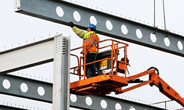Steel Markets

AGC: Prices for Key Construction Materials Continue to Rise
Written by Tim Triplett
September 10, 2021
The prices contractors pay for construction materials continued to increase in August, while many firms reported struggles to get those materials delivered on time, according to an analysis of government data by the Associated General Contractors of America. AGC urged Washington officials to address the challenges affecting the entire supply chain and driving the price escalations.
“July was the seventh-straight month of double-digit price increases for construction inputs,” said Ken Simonson, the association’s chief economist. “Adding to the challenge, contractors are struggling to pass along even a fraction of these added costs to their clients.”
The producer price index for new nonresidential construction – a measure of what contractors say they would charge to erect five types of nonresidential buildings – rose 5.6% over the past 12 months. That was little more than a quarter of the 20.6% increase in the prices that producers and service providers such as distributors and transportation firms charged for construction inputs, Simonson noted.
There were double-digit percentage increases in the selling prices of materials used in every type of construction, AGC said. The producer price index for steel mill products increased by 123% compared to last August. The index for lumber and plywood jumped 15.9% during the past 12 months. The index for copper and brass mill shapes rose 45.3% and the index for aluminum mill shapes increased 35.1%. The index for plastic construction products rose 29.6%. The index for gypsum products such as wallboard climbed 22.9%. The index for insulation materials rose 17.2%, while the index for prepared asphalt and tar roofing and siding products rose 15.8%.
In addition to increases in materials costs, transportation and fuel costs also spiked. The index for truck transportation of freight jumped 14.1%. Fuel costs, which contractors pay directly to operate their own trucks and off-road equipment, as well as through surcharges on freight deliveries, also jumped.
A survey of construction firms the association released last week found that most contractors were experiencing delays in shipments of many types of construction materials. AGC urged the Biden administration and Congress to take steps to improve the supply chain and address price inflation, including removing tariffs on key construction materials.
“Contractors are having to pay more for materials even as it becomes harder to predict when those supplies will show up,” said Stephen E. Sandherr, the association’s chief executive officer. “Removing needless measures that are artificially inflating the cost of key materials, such as tariffs, will help employers who are struggling to cover the costs of inflation and uncertainty.”


Tim Triplett
Read more from Tim TriplettLatest in Steel Markets

CRU: Sheet import demand softens as domestic price gains have slowed
US domestic sheet price gains have begun to slow as previously pulled-forward demand has led to a decline in orders.

CMC looks beyond Arizona micro-mill woes to long-term viability of construction mart
Despite the economic and geopolitical upheaval of the last five years, CMC President and CEO Peter Matt points out that the construction market has been an essential element of the way forward.

US importers face stricter rules under revamped S232 tariffs
“CBP expects full compliance from the trade community for accurate reporting and payment of the additional duties. CBP will take enforcement action on non-compliance," the agency said in a March 7 bulletin.

Steel exports rebound in January
US steel exports recovered to a five-month high in January after having fallen to a two-year low in December. This growth follows four consecutive months of declining exports.

Construction spending drops marginally in January
Construction spending edged down slightly in January, slipping for the first time in four months. The US Census Bureau estimated spending at a seasonally adjusted annual rate of $2,196 billion in January, down 0.2% from December’s downward revised rate. The January figure is 3.3% higher than a year ago. January’s result, despite the slight erosion, […]
